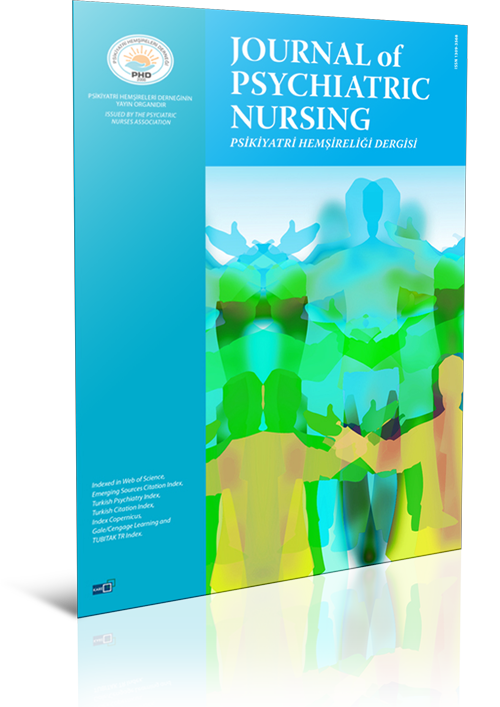
Volume: 8 Issue: 1 - 2017
| 1. | Frontmatter Pages I - III |
| 2. | Editorial Nurhan Eren, Nazmiye Kocaman Yıldırım Page IV |
| QUALITATIVE RESEARCH | |
| 3. | The Prevalence of Substance Use among Adolescents Participating in Apprenticeship Training, Relationship between Anger Level-Anger Expression and Addiction Severity Dilek Avcı, Kevser Tarı Selçuk, Selma Doğan doi: 10.14744/phd.2017.50479 Pages 1 - 8 INTRODUCTION: In this present study, it was aimed to determine the prevalence of substance use among adolescents participating in apprenticeship training and the relationship between anger level-anger expression and addiction severity. METHODS: This cross-sectional study was conducted with 112 adolescents participating in a vocational training center in November 2015. Data were collected with the Personal Information Form, Addiction Profile Index Adolescent Form (API-A) and State-Trait Anger Expression Inventory (STAEI). To perform the analysis, descriptive statistics and Pearson correlation were used. RESULTS: In the study, the results of the API-A revealed that of the adolescents, 7.1% used alcohol every day, 9.8% used a illegal substance, 11.6% tried a illegal substance once or twice and 78.6% had never used any substance. According to the cut-off point of the API-A, of the adolescents who regularly used substances, 53.6% were determined to have clinically significant substance use-related problems. While a positive strong correlation was determined between addiction severity and anger level and extrinsic anger, a positive moderate correlation was determined between intrinsic anger and addiction severity, and a negative correlation was determined between controlled anger and addiction severity (p<0.01). DISCUSSION AND CONCLUSION: In the study, it was determined that 10% of the participating adolescents used an illegal substance, and that the addiction level was serious in about one out of two adolescents who regularly used a substance. The adolescents substance addiction level increased as their trait anger, anger-in and anger-out levels increased and as their anger control level decreased. Therefore, to prevent and to early intervene in substance use and addiction among adolescents, inter-institutional cooperation should be established, initiatives should be scheduled, adolescents should be regularly observed for the substance use, and adolescents anger management should be developed. |
| 4. | Family Burden Among Parents Of Children With Intellectual Disability Fatma Dilek Turan Gürhopur, Ayşegül İşler Dalgıç doi: 10.14744/phd.2017.87609 Pages 9 - 16 Objectives: This study aimed to assess family burden and associated factors among parents of children with intellectual disability. Methods: The study was performed with 467 parents of children with intellectual disability aged between zero to 18 years at Akdeniz University, Department of Pediatric Neurology. The data was collected through face-to-face interviews via a Family Questionnaire Form which was composed in reference to the literature, and a Family Burden Assessment Scale. Family Burden Assessment Scale an instrument comprised of 6 sub-factors and 43 items and measured with a five-point Likert-type (1-5) scale. Higher scores represented more severe family burden. The number and percentage distributions were used for characteristic of the children and parent, correlation analysis was used to determine the relationship between the scale sub-factors and characteristics of children with intellectual disability. Results: All the participants were mothers and the mean score of the mothers in the Family Burden Assessment Scale was quite high (4.16±0.53). The sub-factors that have highest score were perceived inadequacy (4.62±0.53), time requirement (4.51±0.51), emotional burden (4.39±0.59). Physical burden (4.278±1.284), emotional burden (4.632±0.515), economic burden (3.942±1.073), social burden (4.130±0.619) and time requirement (4.788±0.219) of family increased with the intellectual disability level of children. Conclusion: The care, treatment and rehabilitation of children with intellectual disability requires more manpower, cost and time than healthy children. Children who attend special education, depend on self-care or have severe intellectual disability, should support from health and psychosocial professionals in care and coping with. This situation is too important for both mother and family health. |
| 5. | Validity and reliability of the Turkish version of the acceptance of cosmetic surgery scale (ACSS) Semra Karaca, Ayşe Karakoç, Nevin Onan, Hasibe Kadıoğlu doi: 10.14744/phd.2017.72692 Pages 17 - 22 Objectives: Because cosmetic/aesthetic surgery has increased dramatically worldwide, it is necessary to evaluate the reasons and psychosocial situation of the persons proposing to undergo this surgery before any surgical intervention. The aims of the current study were to examine the validity and reliability of the Acceptance of Cosmetic Surgery Scale (ACSS) among Turkish persons. Methods: This methodological study was conducted with 584 participants. Content and construct validity studies were carried out to test the validity of the scale. The construct validity was analyzed with confirmatory factor analysis (CFA). For the scales reliability, the techniques of internal consistency and consistency over time were used. Results: The Turkish adaptation of the ACSS was found to be valid, exhibiting a content validity index in the range of 0.801 on the item level, and 0.90 at the scale level. The scale displayed a three-factor structure. The total Cronbachs alpha coefficient for the scale was 0.92; the Cronbachs alpha coefficient for Factor 1 (Interpersonal) was 0.81; and 0.86 for Factor 2 (Social). The Cronbach alpha coefficient for Factor 3 (Consider) was 0.90. Conclusion: The ACSS is a valid and reliable tool that can be used in assessing acceptance of cosmetic surgery. |
| 6. | The development of a Self-perception of Pregnants Scale and its Psychometric Features Hatice Kumcağız, Ercümend Ersanlı, Naci Murat doi: 10.14744/phd.2017.12599 Pages 23 - 31 Objectives: The aim of this study is to develop the scale of Self-perception of Pregnants, and to determine validity and reliability of that scale. Methods: The sample of present study consists of 326 volunteer pregnants who applied for their routine controls at Ondokuz Mayıs University, Faculty of Medicine. The Cronbach alpha value is found by analyzing inner consistency to determine the reliability of the scale. In addition, explanatory factor analysis is used for the construct validity of the scale. Results: Exploratory factor analysis revealed that the structure of scale is involved in 12 items and two components. The Cronbach Alpha reliability coefficient calculated for the first factor was found to be 0.86; and the Cronbach Alpha was 0.75 for the second factor. A total of 12 items are identified by factor analysis in which the 33.28% of the total variance is explained with factor 1, and the 53.83% of the total variance is explained with factor 2. It is indicated that the Kaiser-Meyer-Olkin coefficient of the scale is 0.86, and the factor loads are between 0.38 and 0.95. The Chi-square value is found to be significant in factor analysis (χ2=128.117; sd=50, p=0.00). According to confirmatory factor analysis results, GFI (.92), NFI (.94), RMSEA (.078), CFI (.96), AGFI (.88) as goodness fit indices were calculated and the findings indicated the model was fit to observed structure. Conclusion: The findings of reliability studies, exploratory and confirmatory factor analysis studies revealed that the scale was reliable and valid data collection tool to identify the pregnants self-perception level. |
| 7. | Perceived level of clinical stress, stress responses and coping behaviors among nursing students Aysel Karaca, Nuriye Yıldırım, Handan Ankaralı, Ferhan Açıkgöz, Dilek Akkuş doi: 10.14744/phd.2017.22590 Pages 32 - 39 Objectives: This study was carried out to determine nursing students perceived levels of clinical stress, stress responses and coping behaviors during their clinical practice. Methods: Data were collected using the Perceived Stress Scale, the Physio-Psycho-Social Response Scale and the Coping Behavior Inventory. Results: According to the Perceived Stress Scale sub-dimensions, stress was caused by lecturers, nurses, homework and workload. It was found that avoidance strategy was used more frequently by students as their perceived stress levels increased. Conclusion: These findings are important for assisting nursing educators to identify stressful factors in the clinical educational environment and for facilitating a discussion of appropriate solutions. |
| 8. | Determining the levels of perceived social support and psychological well being of nursing students. Adeviye Aydın, Nilgün Kahraman, Duygu Hiçdurmaz doi: 10.14744/phd.2017.95967 Pages 40 - 47 INTRODUCTION: The objective of this study is to determine the levels of perceived social support and psychological well being of nursing students. METHODS: The research sample for the study which is of a descriptive nature was comprised of 300 nursing students who were continuing their education during the academic year 2015-2016. Introductory Information Form, Perceived Social Support Scale and Psychological Wellbeing Scale (Short Form) were applied as data collection tools. Kruskal Wallis, Mann Whitney U test, Pearson correlation analysis and regression analysis were used in the assessment of the data. RESULTS: The highest average among perceived social support subscales of nursing students belonged to special person support (23.00) while the lowest average belonged to friend support (21.00). According to the psychological wellbeing scale, the highest average scores were generated in the subscale of positive relations with others (5.43) while the lowest average was found in the subscale of self determination (4.43). The average scores of the third year students in terms of family (KW=8.37, p=0.039), friend (KW=13.29, p=0.004) and special person (KW=20.14, p=0.000) support were higher than those of of the first year students, and the average scores of the fourth year students in terms of individual development (KW=13.30, p=0.004) and positive relations with others (KW=7.87, p=0.049) were higher than those of the first year students. It has been determined that there is a positive relation between the perceived social support levels and psychological wellbeing of nursing students (p<0.01). DISCUSSION AND CONCLUSION: It has been determined that the perceived social support and psychological well being of the students in upper grades were at a better level. It has been determined that as the level of perceived social support of nursing students increased, their psychological wellbeing increased as well. |
| CASE REPORT | |
| 9. | Examination of a patient with Alzheimer's disease at home according to the Conceptual System Model of Imogene King: a case study Hacer Gök Uğur, Oya Sevcan Orak, Seval Ağaçdiken, Şüheda Yüksel doi: 10.14744/phd.2017.41736 Pages 48 - 53 This study is a case report about a patient with Alzheimers disease who received home nursing care according to Imogene Kings conceptual system. It was conducted between January and March, 2015 and included a patient who was registered to the home care unit of a community hospital and diagnosed with Alzheimers disease. During this process, the patient was followed up once a week with 12 home visits. The study data were collected using an introductory information form, the Katz Index of Activities of Daily Living and the Standardized Mini-Mental State Examination, which were prepared by the researchers in accordance with the literature. Care plans were prepared and interventions were implemented using the data obtained and with the help of NANDA nursing diagnoses according to Imogene Kings conceptual system. This case report concluded that nursing care provided to the patient with Alzheimers disease according to Kings conceptual system supported the interaction between the patient and the caregiver/nurse. |
| LETTER TO THE EDITOR | |
| 10. | Three Different Hospitals Samples in Terms of Psychiatric Services Quality Standards: (Student Experience) Leyla Baysan Arabacı, Seda Bozkurt, Esma Fener, Senem Şıttak, Enes Yılmaz, Ömer Tuna doi: 10.14744/phd.2017.53824 Pages 54 - 58 |


















